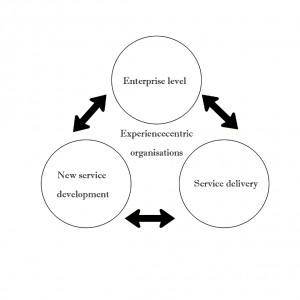This is the second of two posts about the experience-centric organisation. In the previous post I introduced it, and in this one I will explain a little about what it means to become experience-centric.
To design for experiences requires several things. More and more, I see that if you want to have experiences as your competitive advantage, then you have to transform your organisation into an experience-centric organisation to be able to achieve it. I think that we are moving into a decade of experience-centric development. This will have wide-reaching consequences for organisations, most of which we do not understand at the moment.
The difficult thing about designing for experiences in services is that it requires a tight integration across traditional organisational silos, and requires a different way of thinking at all levels of the organisation. In the following diagram, I have divided the experience-centric organisation into three interlinked elements, as summarised below.
The Enterprise level includes all aspects of the enterprise, including organisational structure, culture, reward systems, brand, etc. It requires an alignment around the experience as being crucial for success. The New service development level ensures that new developments are not only experience-centric, but also relevant to the company brand (so, yes, that has to be sorted too). Finally, it all comes together at delivery. Service delivery is possibly one of the most difficult parts of the system to get right. If that is not right, then everything else will be let down.
During a workshop with my colleague, Ted Mathews, we discussed how we can visualise the interrelationships between these there elements, in which the customer experience is clearly shown as something that is dependent upon delivery. Ted came up with this diagram, that to my mind works as a visualisation of the interrelation of all three elements.
The enterprise as a hand requires training and coordination before any experience can be provided at all. The pen as development is the means of delivery, and again, has to fit the hand (enterprise). However, it can have multiple designs, and best fit is key here. The point of delivery is influenced by all other elements, and to leave a lasting experience, it has to have a good interface with the customer and with the pen and hand. What I like about it is that the delivery of the experience is so fragile and a culmination of a huge enterprise and development activity. I’m still getting used to this metaphor and I’m not a 100% sure it works. What do you think?

